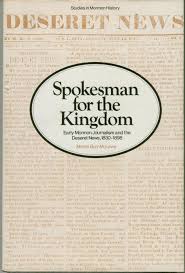Articles/Essays – Volume 11, No. 3
God, Gold, and Newsprint | Monte Burr McLaws, Spokesman for the Kingdom: Early Mormon Journalism and the Deseret News, 1830–1898
Expanded from Monte McLaws’ doctoral dissertation, Spokesman for the Kingdom is a terse, well-researched biography of the Deseret News and Mormon journalism from 1830 to 1898. The book is thematically organized around the topics of early Mormon journalism in the Midwest, the problems of isolation in Utah, the role of the newspaper as builder and defender of the Mormon Kingdom on earth, the newspaper as a molder of character, the newspaper as a corporation and as a reflection of Mormon accomodation with American culture. The writing tends to be professional in the historical sense and the subject matter treated as one would expect in a revised doctoral dissertation. The author weaves his central themes throughout the narrative and strives with some success to be chronological. The author had access to materials in the Historical Department of the Church of Latter-day Saints, and the bibliography is extensive. Because of his access to these materials, Spokesman for the Kingdom lends a sorely needed dimension to our understanding of frontier Mormon journalism.
According to the author, the study concentrates on the nineteenth-century life of the Mormon newspaper and its role as defender of the faith. Inherent in both roles is the conflict between hierarchical manipulation and freedom of the press. McLaws is candid about this dilemma. He points out that almost from its birth in 1850 the editorial columns of the News were subject to editing and approval by Brigham Young. The various editors of the newspaper were also members of the Church hierarchy.
While the News was vital in building the Mormon empire in the West, it also was beset with typical problems. Shortages of newsprint, subscriptions and capital, and problems of gathering news on the frontier plagued the early editors. The conflict between God and gold was always apparent as the editors preached against smoking and drinking alcohol editorially but had to accept gentile advertising promoting those same sins.
In shaping this sometimes fascinating interpretation, McLaws relies heavily on events that were earth-shaking in pioneer Utah but rather ordinary in a contemporary context. We are treated to a description of Brigham Young and Willard Richards gleaning the editorials and sermons for spicy and controversial language. In a later incident, editor Albert Carrington must decide what to do with a letter from an irate citizen of Morgan County claiming that a stake president has jumped his claim. Then there is Apostle Parley Pratt informing a letter writer that Satan was banished to hell because he preferred a warmer climate, and the story of a hard-drinking correspondent for the New York Herald who was convinced that a tall, dark, goateed Mormon was trying to assassinate him.
The conflict between the Salt Lake Tribune and the Deseret News provides McLaws with an opportunity to insert into his narrative the most attractive interpretations. Born as a liberal alternative to the conservatism of the Church hierarchy, the Tribune between 1870 and 1886 grew to have three times more subscribers than the News. Pressed by both the competition of the Tribune and its criticisms of the Church, the News in the 1880s abandoned a long-time practice of restraint and lashed out in vitriolic editorials. While polygamy and Church domination of the intellectual life of the Saints were the earliest topics for Tribune editorial attacks, more earthy issues intensified the debate. According to McLaws, the battle between the two antagonists peaked in 1884 over coverage of the lynching of a black man, the trial of a well-known polygamist and an abortion case. Despite these adolescent quarrels, the News and Tribune matured and grew to be substantial corporations. By the time this book was published the two newspapers were sharing publishing facilities, circulation departments, and advertising staffs.
Although primarily concerned with the analysis of Mormon journalism, the writer also provides some fuel to provoke debate among historians. Hubert Howe Bancroft, in his 1890 History of Utah, offered the thesis that the Church and its newspaper supported the Union cause when Civil War broke out in 1860. McLaws questions that conclusion. Relying on editorials in the Deseret News both prior to and during the war, McLaws suggests the argument that the Church was closely aligned with the Southern attitude toward slavery and states rights before the war and did not shift to a positive support for the North until Northern victories in 1863 made the outcome of the war inevitable. In another excursion into historiography, McLaws is very critical of Hirshson’s The Lion of the Lord (1969). Hirshson’s sin is his uncritical use of eastern newspapers as primary sources.
Although the author sometimes moves unsteadily from a topical to a chronological approach and back, this interpretation of Mormon journalism adds a needed dimension to our understanding of the Church. His analysis of frontier journalism is the strength of the book, however. McLaws admits that frontier journalism was often personal and prejudiced. The strength of the book is the author’s willingness to apply that premise to his subject. Historians often become too familiar with their subjects to be totally objective. This writer makes a creditable effort.
Spokesman for the Kingdom: Early Mormon Journalism and the Deseret News, 1830-1898. By Monte Burr McLaws. Provo, Utah: Brigham Young University Press, 1977. 252 pp., index, illus. $9.95.


 Back to full Issue
Back to full Issue

